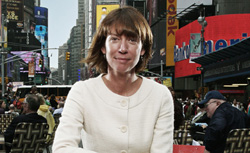Bridge-and-Tunnel Vision
New York City Transportation Commissioner Janette Sadik-Khan describes her vision for the city's future.
New York City is a global leader in everything from fashion to food to finance—but cannot afford to take this position for granted. We compete with cities around the world to attract and retain businesses and people.
Building streets that make it easier to get around and make the city more attractive for businesses and residents is a key economic-development strategy for New York, set by Mayor Michael Bloomberg in PlaNYC, the sustainability blueprint he issued in 2007. Early successes include new pedestrian areas in Times Square and other sites around the city, a new model for bus service and an expanded cycling network. All of these attract many thousands of patrons daily.
Now we are launching another round of innovations across New York's transportation spectrum. If you're in a car, we're deploying the latest traffic-management technology to keep you moving. If you're walking, you can take advantage of a comprehensive information system geared specifically to navigating New York on foot. If you're making a trip that is just too far to walk but not worth a cab or subway ride, you will soon be able to hop on one of our smart public bikes.
There are 8.4 million New Yorkers, and everyone is a pedestrian at some point during the day. While we have 1.3 million street signs, virtually none of them specifically helps pedestrians get around. That's why we're implementing a new system of "wayfinding" signs with clear neighborhood-level maps and that provide walking times to nearby landmarks and adjacent districts.
In Midtown Manhattan, we've just hardwired the streets in a 110-square-block area with microwave sensors, traffic video cameras, and antennae to improve traffic. Using sophisticated traffic algorithms, this enables our traffic engineers to implement traffic-light changes in real time with the push of a button to minimize the impact of congestion.
We're also about to unfold a private-sector bike-sharing program to New York, adding a convenient and affordable way to get across town without the hassle or make that visit two neighborhoods away in a snap. We've fielded questions for several years now about NYC will join the ranks of cities with great public bike systems. Our network of new-design bike lanes—and big increases in people using them—says the time is right.
More travel choices, reduced congestion, and a streetscape that reflects the city's social, entrepreneurial, and cultural vitality will keep New York at the top of the list of the world's best cities.

